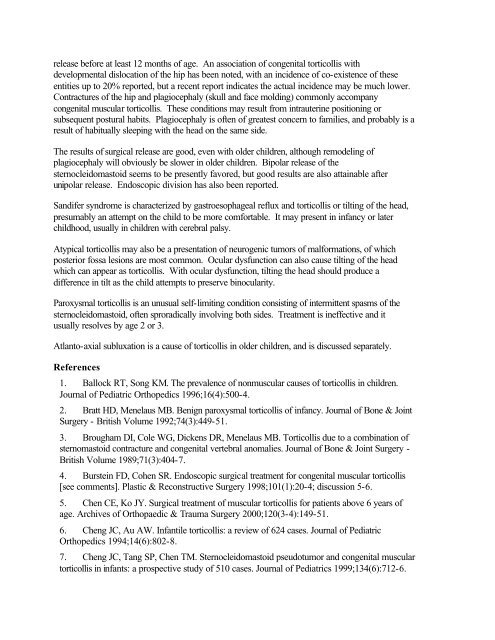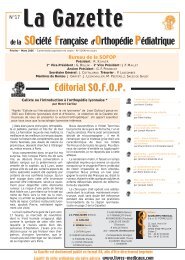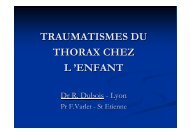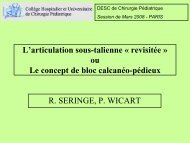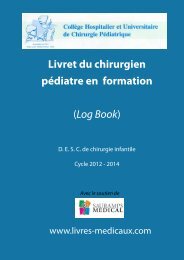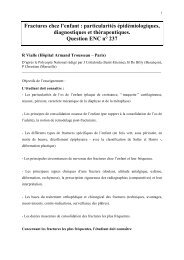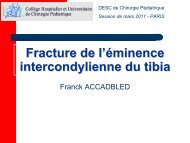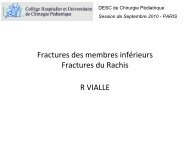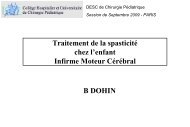Torticollis - SOFOP
Torticollis - SOFOP
Torticollis - SOFOP
- No tags were found...
Create successful ePaper yourself
Turn your PDF publications into a flip-book with our unique Google optimized e-Paper software.
elease before at least 12 months of age. An association of congenital torticollis withdevelopmental dislocation of the hip has been noted, with an incidence of co-existence of theseentities up to 20% reported, but a recent report indicates the actual incidence may be much lower.Contractures of the hip and plagiocephaly (skull and face molding) commonly accompanycongenital muscular torticollis. These conditions may result from intrauterine positioning orsubsequent postural habits. Plagiocephaly is often of greatest concern to families, and probably is aresult of habitually sleeping with the head on the same side.The results of surgical release are good, even with older children, although remodeling ofplagiocephaly will obviously be slower in older children. Bipolar release of thesternocleidomastoid seems to be presently favored, but good results are also attainable afterunipolar release. Endoscopic division has also been reported.Sandifer syndrome is characterized by gastroesophageal reflux and torticollis or tilting of the head,presumably an attempt on the child to be more comfortable. It may present in infancy or laterchildhood, usually in children with cerebral palsy.Atypical torticollis may also be a presentation of neurogenic tumors of malformations, of whichposterior fossa lesions are most common. Ocular dysfunction can also cause tilting of the headwhich can appear as torticollis. With ocular dysfunction, tilting the head should produce adifference in tilt as the child attempts to preserve binocularity.Paroxysmal torticollis is an unusual self-limiting condition consisting of intermittent spasms of thesternocleidomastoid, often sproradically involving both sides. Treatment is ineffective and itusually resolves by age 2 or 3.Atlanto-axial subluxation is a cause of torticollis in older children, and is discussed separately.References1. Ballock RT, Song KM. The prevalence of nonmuscular causes of torticollis in children.Journal of Pediatric Orthopedics 1996;16(4):500-4.2. Bratt HD, Menelaus MB. Benign paroxysmal torticollis of infancy. Journal of Bone & JointSurgery - British Volume 1992;74(3):449-51.3. Brougham DI, Cole WG, Dickens DR, Menelaus MB. <strong>Torticollis</strong> due to a combination ofsternomastoid contracture and congenital vertebral anomalies. Journal of Bone & Joint Surgery -British Volume 1989;71(3):404-7.4. Burstein FD, Cohen SR. Endoscopic surgical treatment for congenital muscular torticollis[see comments]. Plastic & Reconstructive Surgery 1998;101(1):20-4; discussion 5-6.5. Chen CE, Ko JY. Surgical treatment of muscular torticollis for patients above 6 years ofage. Archives of Orthopaedic & Trauma Surgery 2000;120(3-4):149-51.6. Cheng JC, Au AW. Infantile torticollis: a review of 624 cases. Journal of PediatricOrthopedics 1994;14(6):802-8.7. Cheng JC, Tang SP, Chen TM. Sternocleidomastoid pseudotumor and congenital musculartorticollis in infants: a prospective study of 510 cases. Journal of Pediatrics 1999;134(6):712-6.


